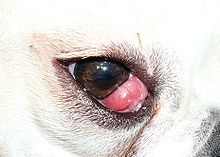- Cherry eye
-
Cherry eye is the term used to refer to canine nictitans gland prolapse, a common congenital eye defect in various dog breeds where the gland of the third eyelid known as the nictitating membrane prolapses and becomes visible. Commonly affected breeds include the Bulldog, Chihuahua, Cocker Spaniel, Beagle, Pekingese, Neapolitan Mastiff, and Basset Hound.[1] Cherry eye may be caused by a hereditary weakness in the connective tissue surrounding the gland.[2] It is most common in puppies.[3]
It appears as a red mass in the inner corner of the eye, and is sometimes mistaken for a tumor. After gland prolapse, the eye becomes chronically inflamed and there is often a discharge. Because the gland is responsible for about 30% of the eye's tear production, the eye can eventually suffer from dryness (keratoconjunctivitis sicca).[4] Dry eye may eventually occur in 30 to 40 percent of dogs that have the gland removed, yet it may affect about 20 percent of dogs that have the gland surgically replaced [5]
Surgery is the usual treatment. Older methods of cherry eye correction (before the gland's purpose was known) involved simply removing the gland, but this is a last-resort procedure today, and necessitates the use of eyedrops for the rest of the animal's life. Modern methods of cherry eye correction involve repositioning of the gland to its normal location. The success rate of this type of surgery is around 80% in most breeds.
While most common in dogs, the condition is also found in certain breeds of cat as well, particularly the Burmese and Bombay.
References
- ^ Herrera, Daniel (2005). "Surgery of the Eyelids". Proceedings of the 30th World Congress of the World Small Animal Veterinary Association. http://www.vin.com/proceedings/Proceedings.plx?CID=WSAVA2005&PID=10970&O=Generic. Retrieved 2007-04-24.
- ^ Schoofs S (1999). "Prolapse of the gland of the third eyelid in a cat: a case report and literature review". Journal of the American Animal Hospital Association 35 (3): 240–2. PMID 10333264.
- ^ Christmas (1992). "Common ocular problems of Shin Tzu dogs". The Canadian veterinary journal. La revue veterinaire canadienne 33 (6): 390–393. PMC 1481255. PMID 17424020. http://www.pubmedcentral.nih.gov/articlerender.fcgi?tool=pmcentrez&artid=1481255.
- ^ Gelatt, Kirk N. (ed.) (1999). Veterinary Ophthalmology (3rd ed.). Lippincott, Williams & Wilkins. ISBN 0-683-30076-8.
- ^ "Nasolacrimal and Lacrimal Apparatus". The Merck Veterinary Manual. 2006. http://www.merckvetmanual.com/mvm/index.jsp?cfile=htm/bc/30107.htm. Retrieved 2007-04-24.
External links

This veterinary medicine–related article is a stub. You can help Wikipedia by expanding it.

